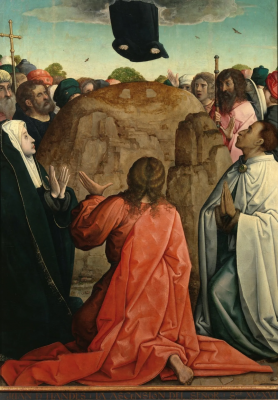Gospel in Art: Solemnity of the Ascension of the Lord

The Ascension, by Juan des Flandres (1447-1519) © Prado Museum, Madrid
Source: Christian Art
Gospel of 9 May 2024
Mark 16:15-20
Jesus showed himself to the Eleven and said to them:
'Go out to the whole world; proclaim the Good News to all creation. He who believes and is baptised will be saved; he who does not believe will be condemned. These are the signs that will be associated with believers: in my name they will cast out devils; they will have the gift of tongues; they will pick up snakes in their hands, and be unharmed should they drink deadly poison; they will lay their hands on the sick, who will recover.'
And so the Lord Jesus, after he had spoken to them, was taken up into heaven: there at the right hand of God he took his place, while they, going out, preached everywhere, the Lord working with them and confirming the word by the signs that accompanied it.
Reflection on the painting
In our painting by Juan des Flandres (a Flemish artist active in Spain), painted between 1514 and 1519, we see Christ, veiled by a cloud, ascending into heaven. Mary and the apostles are witnessing the event, with James occupying a prominent position among them. James is depicted with a staff and a pilgrim's hat. The upper part of Christ's body is deliberately obscured, drawing attention to his footprints atop the Mount of Olives. This panel, along with three others by the same artist, once adorned the main altarpiece at the Church of San Lázaro in Palencia.
It is very effective just to show the feet of Christ, implying that the rest of his body is outside the painting, having moved into a different space. Christ's physical departure from the earthly realm and his ascension into heaven mark the end of his earthly mission. By highlighting the footprints, the artist underscores the tangible evidence of Christ's presence and how his departure was a real event, reinforcing the spiritual significance for us the viewer.
Our Gospel reading today for the feast of the Ascension stresses exactly this point. It makes clear that the moving on of Jesus as a result of his ascension did not lead to an absence from his disciples. At the end of today's gospel reading we read, 'the Lord Jesus was taken up into heaven'. Yet, the very next sentence states, 'the Lord working with them and confirming the word by the signs that accompanied it'. The Lord was taken up, he was taken away, and yet he was working with them. The Lord did not ascend to distance himself from the church: on the contrary, he ascended to be closer to it.
LINKS
Gospel in Art: https://christian.art/
Today's Reflection: https://christian.art/daily-gospel-reading/mark-16-15-20-2024-2/


















